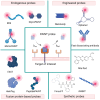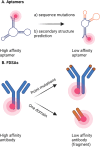Beyond DNA: new probes for PAINT super-resolution microscopy
- PMID: 37306078
- PMCID: PMC10318573
- DOI: 10.1039/d3cc00757j
Beyond DNA: new probes for PAINT super-resolution microscopy
Abstract
In the last decade, point accumulation for imaging in nanoscale topography (PAINT) has emerged as a versatile tool for single-molecule localization microscopy (SMLM). Currently, DNA-PAINT is the most widely used, in which a transient stochastically binding DNA docking-imaging pair is used to reconstruct specific characteristics of biological or synthetic materials on a single-molecule level. Slowly, the need for PAINT probes that are not dependent on DNA has emerged. These probes can be based on (i) endogenous interactions, (ii) engineered binders, (iii) fusion proteins, or (iv) synthetic molecules and provide complementary applications for SMLM. Therefore, researchers have been expanding the PAINT toolbox with new probes. In this review, we provide an overview of the currently existing probes that go beyond DNA and their applications and challenges.
Conflict of interest statement
There are no conflicts to declare.
Figures










Similar articles
-
Completing the canvas: advances and challenges for DNA-PAINT super-resolution imaging.Trends Biochem Sci. 2021 Nov;46(11):918-930. doi: 10.1016/j.tibs.2021.05.010. Epub 2021 Jul 8. Trends Biochem Sci. 2021. PMID: 34247944 Free PMC article. Review.
-
In Situ Imaging of Proteins Using DNA-PAINT Super-Resolution Microscopy.Methods Mol Biol. 2024;2800:103-113. doi: 10.1007/978-1-0716-3834-7_9. Methods Mol Biol. 2024. PMID: 38709481
-
Improved resolution in single-molecule localization microscopy using QD-PAINT.Exp Mol Med. 2021 Mar;53(3):384-392. doi: 10.1038/s12276-021-00572-4. Epub 2021 Mar 2. Exp Mol Med. 2021. PMID: 33654221 Free PMC article.
-
Fast, Background-Free DNA-PAINT Imaging Using FRET-Based Probes.Nano Lett. 2017 Oct 11;17(10):6428-6434. doi: 10.1021/acs.nanolett.7b03425. Epub 2017 Sep 21. Nano Lett. 2017. PMID: 28871786
-
About samples, giving examples: Optimized Single Molecule Localization Microscopy.Methods. 2020 Mar 1;174:100-114. doi: 10.1016/j.ymeth.2019.05.008. Epub 2019 May 10. Methods. 2020. PMID: 31078795 Review.
Cited by
-
Deep learning-enabled fast DNA-PAINT imaging in cells.Biophys Rep. 2023 Aug 31;9(4):177-187. doi: 10.52601/bpr.2023.230014. Biophys Rep. 2023. PMID: 38516619 Free PMC article.
-
Resolving the Nanoscale Structure of β-Sheet Peptide Self-Assemblies Using Single-Molecule Orientation-Localization Microscopy.ACS Nano. 2024 Mar 26;18(12):8798-8810. doi: 10.1021/acsnano.3c11771. Epub 2024 Mar 13. ACS Nano. 2024. PMID: 38478911 Free PMC article.
-
Super-resolution microscopy to study membrane nanodomains and transport mechanisms in the plasma membrane.Front Mol Biosci. 2024 Sep 3;11:1455153. doi: 10.3389/fmolb.2024.1455153. eCollection 2024. Front Mol Biosci. 2024. PMID: 39290992 Free PMC article. Review.
-
Multiplexed Lectin-PAINT super-resolution microscopy enables cell glycotyping.Commun Biol. 2025 Feb 20;8(1):267. doi: 10.1038/s42003-025-07626-7. Commun Biol. 2025. PMID: 39979385 Free PMC article.
-
Self-Blinking Thioflavin T for Super-resolution Imaging.J Phys Chem Lett. 2024 Aug 1;15(30):7591-7596. doi: 10.1021/acs.jpclett.4c00195. Epub 2024 Jul 19. J Phys Chem Lett. 2024. PMID: 39028951 Free PMC article.
References
Publication types
MeSH terms
Substances
LinkOut - more resources
Full Text Sources

